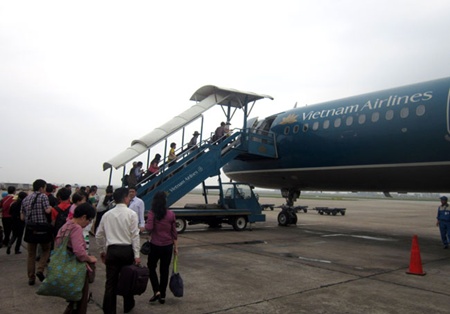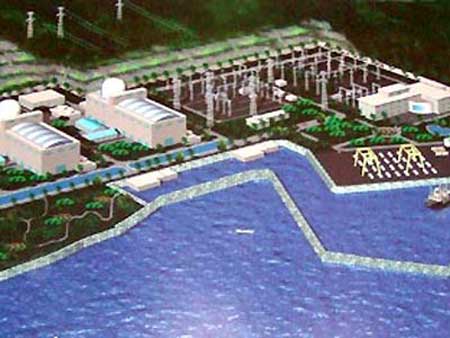|
Global bodies warn that milk
substitutes put babies at risk
HA NOI (VNS)-
WHO and UNICEF have warned that Vietnamese children's health could be at risk
because of inappropriate labelling and marketing of breast milk substitutes
on sale.
Incorrectly renaming breast milk substitutes as
"complementary food" or "nutrition products", makes them
fall outside the regulatory authority of the Ministry of Finance, they said.
Also, the price of breast milk substitutes on sale in
At the same time, the labelling issue affects the
implementation of the Law on Advertisements which came into force in January.
This law bans advertisements for breast milk substitutes for children up to
two years.
The use of these terms is said to be confusing for consumers,
distracting buyers from the global evidence that provides clear
recommendations for feeding infants and young children.
WHO and UNICEF said that infants should be exclusively
breastfed for the first six months of life to achieve optimal growth,
development and health. From the age of six months, breast milk remains the
most appropriate liquid part of a diet for most children up to two years of
age, once complementary feeding has begun.
WHO warns that specially formulated milks or so-called
"follow-up milks" are not necessary, and even unsuitable when used
as a breast-milk replacement.
Current formulations lead to higher protein intake and lower
intake of essential fatty acids, iron, zinc and B vitamins than those
recommended by WHO for adequate growth and development of infants and young
children.
In
Complementary feeding refers to the period when breast milk
alone is no longer sufficient to meet the nutritional requirements of infants
and young children, and other foods are needed, along with breast milk.
Simply because a product is fed during the complementary
feeding period between eight and 24 months, as in the case of ‘follow-up'
formula, does not mean it is a complementary food.
Nguyen Thanh Lan, mother of an 18-year-month boy in Hai Ba
Trung District, said she did not pay attention to the labelling of formula
milk as complementary foods or baby formula when choosing milk powder
products.
"I do not clearly understand the differences between
quality of milk products labelled as supplementary foods and baby
formula."
Early this year, a scandal involving Danlait milk product
raised concern about milk quality. Danlait, a goat milk product from
To safeguard the health and development of Vietnamese
children, WHO and UNICEF strongly recommend that the Ministries of Health and
Finance classify "follow-up" formulas correctly as milk products.
This would ensure that they will be subject to price control and covered by
marketing restrictions as contained in the International Code on Marketing of
Breastmilk Substitutes.- VNS
|
Thứ Hai, 30 tháng 9, 2013
Party Central Committee convenes eighth conference
The overview of the conference (Photo: VNA)
The Communist Party of
Vietnam Central Committee (CPVCC) (11th tenure) convened its eighth
conference in Hanoi on September 30, under the chair of General
Secretary Nguyen Phu Trong.
The conference will see debates and
comments made on this year’s socio-economic performance, socio-economic
development for 2014, three-year implementation of the 11th National
Party Congress’s Resolution on socio-economic development and a draft
project on basic and comprehensive renewal in education and training to
meet industrialisation and modernisation needs.
During the event, the delegates will study the draft amendments to the 1992 Constitution, review the decade-long implementation of the Resolution on the Strategy on Fatherland Defence adopted at the eighth conference of the CPVCC (11th tenure) and other important issues pertaining to Party building. In an opening speech, General Secretary Trong brought up issues for in-depth discussion, relating to education renewal, the amendments to the 1992 Constitution, the making of a strategy to defend the country in the new circumstance and the Party building work. Regarding socio-economic development, he suggested the delegate analyse and come up with accurate assessments of the country’s socio-economic situation, focusing on the execution of the three adopted strategic breakthroughs in association with growth model change and economic restructuring. The analysis and assessments will help outline major viewpoints, instructions, goals, tasks and measures for the country in 2014 and in the 2014-15 period, aiming to realise the 11th National Party Congress’s Resolution with maximal outcomes, he said. The Party General Secretary also pointed to the review of the ten-year implementation of the Resolution on the Strategy on Fatherland Defence issued at the eighth conference of the CPVCC as critical in the new circumstance.
The work aims at analysing and evaluating comprehensively, profoundly
and systematically the current situation facing the country and lay down
proper and orientations, policies and measures that soundly fit the
country’s requirements and tasks arisen from the new situation, Party
chief Trong emphasised.
In the speech, he also talked about the issuance of regulations on election in the Party and the establishment of sub-committees to prepare for the Party’s 12th Congress, which will be considered and decided during this session. He requested the delegates bring into full play their sense of responsibility when analysing and debating the raised issues in order to generate profound ideas for reports and projects that can be decided at the end of the conference.
The conference is scheduled to conclude on October 9./.- VNA
|
|
All six
companies in the aviation sector reported profits, said Lai Xuan Thanh, head
of the Civil Aviation Authority of
Vietnam Airlines Corporation, Vietnam Air Navigation Services
Corporation and Airports Corporation of
Vietnam's budget private carrier, VietJetAir, also reported
VND120 billion (US$5.7 million) pre-tax profits for the first seven months of
the year while Jetstar Pacific and Vietnam Air Service Company (VASCO) announced
profits for the first time.
VietJetAir's executive director Luu Duc Khanh said that making
a profit was beyond the company's expectations after only two years of
operation. They initially set a modest goal of breaking even within three
years.
A representative from VASCO said that the company had a
balance of VND23 billion in the eight-month period and had effectively
exploited the domestic routes.
The information surprised experts, given that airline
companies faced many difficulties in the past three years with several firms
closing.
In February, Air Mekong temporarily ceased operation to
restructure; Jetstar also experienced financial difficulties.
Luu Thanh Binh, deputy head of CAAV, expressed optimism about
the market, saying that Asia in general and
Binh predicted that the domestic aviation market would have a
growth rate of 15 per cent in terms of passenger transport.
He attributed the strong showing to increasing interest in air
travel as well as
He said air crew restructuring helped Jetstar Pacific become
profitable, while changing from the Boeing 737-400 to A320 model helped the
company save 17 per cent of control costs over the same period last year.
However, both experts warned that
the increasing popularity of budget carriers posed a significant threat to
both economy and high-class market segments that could show an effect by the
end of the year. - VNS
|
|
Latest
reactor generation for Ninh Thuan 1
The Russian State Atomic Energy
Corporation ROSATOM has been selected as the technology provider for
* Could you tell us more about
Generation III+ nuclear reactor?
The Ninh Thuan 1 Nuclear Power Plant will be applied
Pressurized Water Reactor (VVER). In case of troubles, radioactive substances
and radioactive waste will be kept and completely isolated within the secure
area. Barriers to prevent radioactive substances will also be arranged around
the plant, contributing to ensuring the safety.
The nuclear power plant will be built with a series of
active and passive safety programs and systems. The passive safety system can
operate without the support of external voltage. This system works on the
principles of gravity and heat exchange. Operators cannot intervene to turn
on or off the system.
The nuclear power plant will also be applied the system
to isolate molten substances (core catching). This system was not applied in
nuclear power plants in
* Which nuclear power plants were
applied core catching?
Rosatom began to apply this system in nuclear power
plants in
* The public pays special attention
to safe issues in nuclear power plants. What activities will be implemented
to ensure the safety for the Ninh Thuan 1 Nuclear Power Plant?
Rosatom completed documents to evaluate the safety of
the construction site of the Ninh Thuan 1 Nuclear Power Plant. In addition,
field work and pre-feasibility report before construction are proceeding
according to schedule to ensure safe conditions for the plant.
Legal documents to ensure the safety in the
construction of
Rosatom will support
* Could you tell use more about
Russian-Vietnamese cooperation in the preparation of human resources?
To construct and operate the Ninh Thuan 1 Nuclear Power
Plant, it is necessary to have about 1,500 people, including 300 workers, 700
engineers, 300 employees in the monitoring units, experts from the Vietnam
Electricity and staff from relevant ministries and departments.
To support
Source:
|
|
$340 million road opens for traffic in HCM City
A five-kilometre section of the Tan Son Nhat- Binh Loi Outer
Ring Road in HCM City opened to traffic on Saturday.
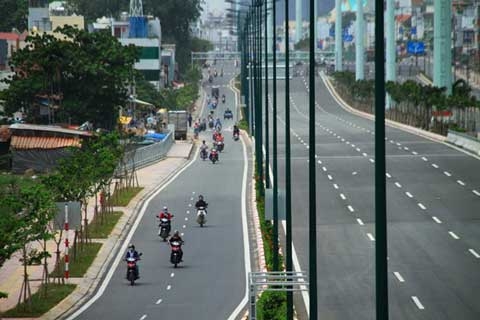
It has 12 lanes and runs from Nguyen Thai Son intersection not far from the airport to National Highway 13.
The
1.1km, 12-lane Binh Loi Bridge across the Sai Gon River is on the
highway, which is named under after former Prime Minister Pham Van Dong.
The bridge is expected to serve around 40 per cent of the traffic crossing the Sai Gon River from the city.
It
is an important part of the ring road, serving to connect Tan Son Nhat
International Airport with industrial parks in Binh Duong Province
through National Highway 13.
It is expected to help reduce
traffic, accidents, and pollution on severely congested roads like Xo
Viet Nghe Tinh, Dinh Bo Linh, Bach Dang, Phan Dang Luu, and Phan Van Tri
streets.
The ring road, to measure a total of 13.6km, starts at
the airport in Tan Binh District and will end in Thu Duc District at
National Highway 1.
It will run through the districts of Go Vap and Binh Thanh.
It will cost nearly US$495 million, with land and relocation accounting for $281.3 million.
Construction began in 2008. It is 75 per cent complete and expected to be finished next year.
It
is the country's first BT (build - transfer) project in collaboration
with a foreign partner, South Korea-based GS E&C Company, Nguyen Huu
Tin, deputy chairman of the city People's Committee, said.
Nearly 4,000 households with 30,000 people had to be relocated for the work, he added.
The new road in pictures:
 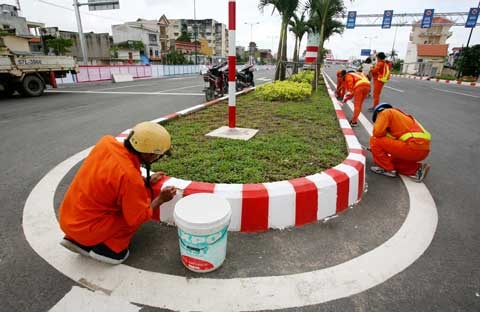 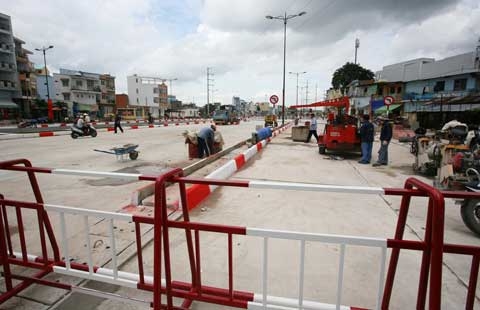 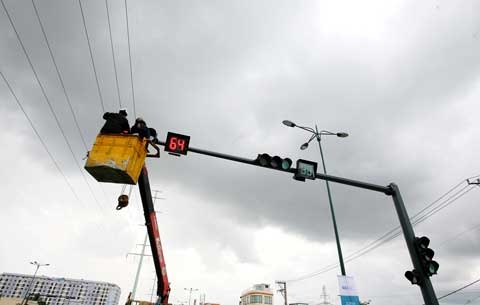 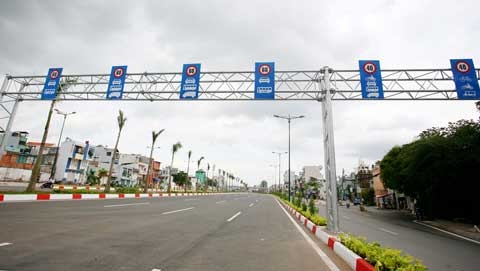   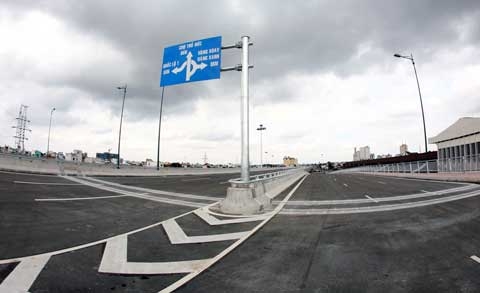 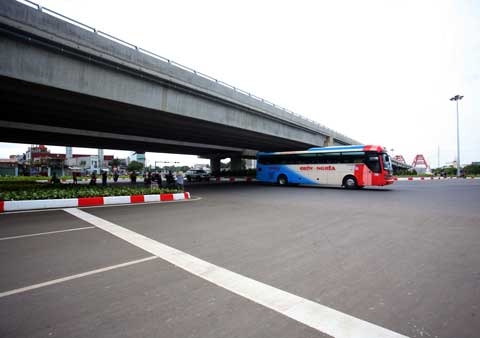  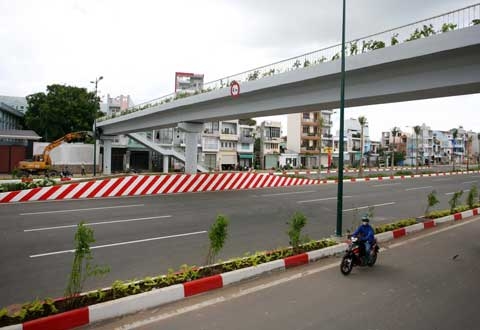 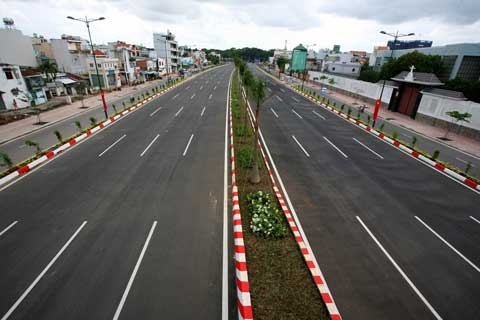
VNA/VNN
|
|
BUSINESS
IN BRIEF 1/10
For the rest of the
year,
Speaking recently
at a meeting to review socio-economic development in the first three
quarters, Quan said if hindrances facing the city's businesses were curbed in
the fourth quarter, the city could attain high GDP growth, helping to bring
the country's GDP growth rate to 5.5 per cent in 2013.
The local economy
has shown signs of recovery, based on recent figures from the city's Taxation
Bureau on the number of newly established businesses and those that have
resumed operation.
In the first eight
months of the year, 18,384 new businesses were established and 4,704 resumed
operations. However, over the same period, 15,343 businesses were dissolved
in the city.
Of the businesses
declaring taxes on their profits, the figure rose from 36 per cent last year
to 33 per cent in the first quarter and 28 per cent in the second quarter,
according to Tran Thi Le Nga, deputy head of the Taxation Bureau.
The Deputy Director
of the city's Department of Industry and Trade, Le Ngoc Dao, was quoted as
saying in Thoi Bao Kinh Te Sai Gon (Saigon Economic Times) news magazine that
the rate of inventory in
Le Chi Hieu, the
deputy chairman of
He added that many
of them had suspended or scaled down operations and cut staff. Some of them
had "retreated from the property market" altogether.
According to Thai
Van Re, director of the city's Department of Planning and Investment,
The city attained
GDP of VND532.414 triillion (nearly US$25.8 billion) in the first three
quarters of 2013, a growth of 8.7 per cent compared with the same period last
year.
As a result, the
GDP growth for the year is estimated at 9.2 per cent, slightly below the
target of 9.5 pert cent.
Retailers are
turning away from shopping malls around the country because rents are too
high but not enough customers to generate revenues.
A Tuoi Tre (Youth)
newspaper report said in Lotte building in
At
"Most visitors
coming to the centre these days seem interested only in window
shopping." Trang, the owner of a shop selling fashion garments there,
told Tuoi Tre.
"The decline
in sales in the last two years has made us miserable.
Lac, another shop
owner, said she is seeking to sell or sublease her shop because business is
stagnant and she is not making enough money to even pay her rent.
In
Huong Thuy, who has
a fashion shop there, said few customers visit during weekdays, and the
weekend business is not high enough to make a difference.
The manager of a
shopping centre in Tan Binh District said rents have been cut three times in
the last one year after many tenants returned their shops to the owners.
The tenants are
looking for space outside the centre to cut costs.
He added that three
shopping malls – TS Plaza in District 7 and
According to a
report from real estate services provider CBRE, many retailers have quit the
market in the second quarter, leaving shops vacant at business centres and
shopping malls in both inner and suburban districts in
It said retailers
leaving the inner districts of HCM City include Home One (returning
1,200sq.m), Gloria Jean's (100 sq.m), Nike (150sq.m), Banana Leaf (100 sq.m),
and Givral (100 sq.m)
High rents but
small number of visitors plague the sector, it said.
According to a
master plan from the Ministry of Industry and Trade, by 2020
Ornamental
fish make profit splash
Exports of
ornamental fish from
In the first nine
months of the year,
Tong Huu Chau,
owner of the Chau Tong Ornamental Fish Enterprise in
Many new partners
from the
Ho Nhuan Dang Son,
general secretary of the Long An Province's Ornamental Creatures Association,
said that export orders had been rising since the beginning of the year.
Son said he earned
a profit last year of nearly VND500 million (US$23,800) from raising 100
tanks of discus fish and 2ha of other ornamental fish.
The EU accounts for
73 per cent of
Enterprises said,
however, that Vietnamese ornamental fish exports still faced several
technical barriers from import countries.
Chau said that four
carp exporters in
The city's
Department of Agriculture and Rural Development, along with the Agriculture
and
This practice will
be applied on a pilot basis at several ornamental fish farms next month, said
the association.
Last year, the city
exported VND400 billion (US$19 million) of ornamental fish, up two times
against 2008, said the department.
The city now raises
more than 63 million ornamental fish, up 14.5 per cent against the same
period last year, it said.
Car makers
take early imports turn
The struggling
A report from the
Viet Nam Automobile Manufacturers' Association (VAMA) showed that its members
sold 92,000 units in 2012, a fall of 33 per cent compared with 2011.
When the presently
high taxes dropped to zero in 2018, cars from ASEAN countries are expected to
flood into
Toyota Motor
Vietnam (TMV) will display Lexus cars from
According to Honda
Vietnam's sales manager, Tomohiro Maruto, after three months of launching the
model, the company has received more than 1,600 orders but delivered only
about 300 units. It has raised production capacity to 600 units a year, but
this is still not enough. The company also plans to import the Accord model
by the end of this year.
Mitsubishi, whose
strong position in four-wheel-drive vehicles, will also display two small
sedans for women motorists at the motor show in
And Ford
According to the
Viet Nam Customs, more than 23,000 completely-built units have been imported
to
Deputy Director of
Vinastar, Kiyoshi Teshima, said Mitsubishi had been assembling cars and
selling imported ones.
At present, most
cars from ASEAN sold in
Although the three
countries are not members of ASEAN, the regional group will reduce their import
taxes to 5 per cent by 2018.
Many car makers in
They said to lower
prices, they needed more locally-made spare parts, but the country's support
industry was still weak.
Rubber
exports hit $1.68b in first 9 months of 2013
The country
exported 100,000 tonnes of rubber this month, reaping a turnover of US$223
million, according to the Ministry of Agriculture and Rural Development's
statistics.
The latest addition
has brought the volume of exported rubber in the first nine months total to
710,000 tonnes, earning the country $1.68 billion. The exports, however,
experienced yearly decrease of 1.2 per cent in volume and 17.8 per cent in
value.
Can Tho
businesses eager to penetrate UAE market
Businesses in Can
Tho city would greatly benefit if they were able to penetrate the
Vietnamese
businesses and those in the Cuu Long (Mekong) Delta in particular, however,
were facing tremendous difficulties as a result of the global economic
recession and technical barriers when entering choosy markets like the US, EU
and Japan, said Deputy Chairman of the municipal People's Committee Dao Anh
Dung.
Co.opmart
offers large discounts for Women's Day
Supermarket chain
Sai Gon Co.op expects sales to increase by at least 50 per cent in October
after it rolled out five big promotions to mark Viet Nam Women's Day on
October 20.
It is offering a 50
per cent discount on consumer goods and garments for women and utensils and a
"buy one get one free" deal.
The discounts, to
run until October 27, are also offered at Co.opXtraplus Thu Duc and Co.op
Food convenience store chains.
Agro-forestry-fishery
exports outstrip $20b mark
The amount has
raised the sector's total export turnover in the first nine months of this
year to $20.45 billion, representing a year-on-year increase of 0.5 per cent.
Among the export
items, pepper and cashew recorded the most impressive growth in both volume
and value.
Over the past three
quarters,
The
Meanwhile, pepper
export volume rose by 20.2 per cent to 112,000 tonnes, earning $743 million,
up 16.5 per cent year-on-year.
Wood and wood
product exports brought home $389 million in September and $3.77 billion in
the past three quarters, up 12 per cent over the corresponding time last
year.
The sector's export
to major markets such as the
During the
January-September period, seafood exports experienced a rise of 3 per cent
year-on-year to $4.61 billion.
The
While Viet Nam's
fishery export enjoyed remarkable growth in China, Canada and Thailand with
53 per cent, 13.8 per cent and 13 per cent respectively, the figures in
Japan, the RoK and Germany dropped by 0.6 per cent, 14.1 per cent and 2.6 per
cent.
The country
exported around 471,000 tonnes of rice in September, bringing home $214
million. This fell far short of the country's 650,000 tonne target, itself
lowered from the 750,000 tonne goal previously set by the Viet Nam Food
Association.
In the first nine
months of this year, rice export saw decreases of 14.3 per cent in volume and
16.7 per cent in value with 5.35 million tonnes shipped abroad worth $2.35
billion.
Experts forecast
that the fourth quarter will be gloomy picture for the country's rice exporters,
saying Vietnamese businesses are finding it hard to seek new contracts.
During the reviewed
period, the Vietnamese coffee businesses delivered 1.03 million tonnes to
foreign importers, garnering $2.21 billion, down 23.1 per cent in volume and
22.5 per cent in value year-on-year.
With the present
performance, experts said the yearly target of $4 billion may be out of reach
for the country.
Apart from
At the same time,
VN ranks in
‘dynamism' study
A study by Grant
Thornton has ranked
The Global Dynamism
Index, based on five drivers of an economy's dynamism, gave the country a
score of 54 per cent. This compares with 66.5 per cent for
"The ratings
go well beyond basic GDP data," Grant Thornton CEO Ed Nusbaum said.
"Five areas
were identified as holding the key drivers to an economy's dynamism: business
operating environment, science and technology, labour and human capital,
economics and growth, and the financing environment. Within these groups,
there were 22 key data points that were analysed."
What affected its
overall scores were the business operating environment (down 5 places to
47th), and science and technology (down 3 places to 44th), and it is in these
areas that government and management need to improve to build on
TPP drives
textile, garment firms to step up production
Textile and garment
enterprises in southern
The move aims to
help them take the advantages of the agreement in export activities after the
expected signing of the agreement at year's end.
Nguyen Dinh Truong,
deputy chairman of the Viet Nam Textile and Apparel Association (Vitas), said
after the TPP is signed,
Localities such as
The Dong Nai
Industrial Garment Company based in
To prepare for the
TPP, the Dong Tien Joint Stock Company has started to build infrastructure
for a support industrial complex for the textile and garment industry, said
Vu Ngoc Thuan, the company general director.
The complex has
already attracted five investors to develop support industrial products for
the textile and garment industry.
Bo Ngoc Thu,
director of the Dong Nai Planning and Investment Department, said
However, local
textile and garment companies will have difficulty in getting a preferential
export tax rate after the TPP is signed because, at present, they have had to
import from many countries almost all of their raw material for production.
If they want to
receive the export tax rate of zero under the TPP regulation, they must
import the raw material for the textile and garment industry only from TPP
member countries, Lien said.
To take initiative
in raw material for production, the local enterprises must pour a huge
investment capital into the textile and dye stages, she said.
Thuan said the
difficulty with raw material will not change over the next few years because
investment in the textile and dye industries is not easy.
Many provinces and
cities have not encouraged investment in these industries because they are
afraid of environmental problems, he said.
Additionally, small
and medium sized enterprises having difficulties in capital and workforce
would not be able to approach production and business opportunities from the
TPP, said Thuan, adding that these enterprises have yet made a planned way to
get out of their situation.
Currently,
Vietnamese
enterprises prepared to expand in Asia
Many Vietnamese
small enterprises are now ready to expand business in Asian countries,
according to Thng Tien Tat, Executive Director of Singapore United Overseas
Bank in
Tat was quoted by
He said that UOB
has set up a foreign direct investment (FDI) advisory department to provide
support to Vietnamese businesses seeking to expand operations in
UOB's statistics
showed that trade flow between
The two-way trade
between
According to Edlyn
Khoo, director of
The UOB has opened
seven FDI advisory departments in Asian countries and territories, including
Two other FDI
advisory departments were going to be set up in
Trade with
Two-way trade
between
These figures were
released at an on-line conference organised between Ha Noi and New Delhci on
Thursday.
According to the
Ministry of Industry and Trade, India has become one of Viet Nam's leading
trade partners with bilateral trade increasing by 12.2 per cent a year from
2008-12.
The trade value hit
$3.5 billion in the past eight months, up 40.2 per cent year-on-year.
Vietnamese products
for the
Huy also said the
signing of a Trade And Service Agreement and an Investment Agreement between
ASEAN and
Sufficient
potential existed for the two countries to raise trade to $25 billion by
2020, said a director from
He suggested the
launching of a direct air route linking the two nations and the establishment
of bank branches would help achieve this target.
Sugar
stockpile reaches sweet spot
Sugar inventory
reached 221,310 tonnes as of mid-September, 99,310 tonnes higher than the
same period last year, according to the Department of Processing and Trade
for Agro-forestry-Fisheries Products and Salt Production.
The volume sold
between August 15 to September 15 was 36,300 tonnes higher than the same
period last year, reaching 102,000 tonnes due to increased exports to
The price of sugar
in the domestic market remained stable over the last month at VND15,000
(US$0.7) per kilo.
SBV revokes
licences for new banks
The State Bank of
Viet Nam (SBV) recently decided to revoke the licences for the opening of
Lao-Viet Bank's branches in Ha Noi and
SBV also ordered
the two branches to carry out asset liquidation in compliance with Circular
34/2011/TT-NHNN.
Lao-Viet Bank,
established in 2009, was a joint venture between the Bank for Investment and
Development of Viet Nam and Lao Bank for Foreign Trade.
Syrena Viet
Syrena Viet
The land parcels
range in area from 800-6,200 square metres. Construction licenses were
granted for buildings from four to 30 floors.
About 40 hotels and
restaurants were built in the city in the last five years, according to
Syrena.
Tomorrow, the
company will also release for sale 90 land parcels in Hung Thang New Urban
Zone ranging in size from 175sq.m to 300sq.m.
Businesses
register for promotion month
About 500 businesses
in Ha Noi, including big supermarkets and trade centres, have registered to
participate in the city's special promotion month in November, offering
discounts of up to 50 per cent for many of their products.
The highlight of
the month will be the two "golden days" on November 16 and 17 when
products at special discounts will be available at 25 outlets around the
city.
The capital city
plans to spend VND3 billion (US$143,000 USD), including about VND1.2 billion from
the city budget, on the promotional activities.
Mobile
users to swap networks
Mobile phone users
can now change networks and still keep their phone numbers, following
Decision No.1178 of the Ministry of Information and Communications (MIC)
published on Wednesday.
But don't hold your
breath, the new service is about four years away.
A national network
transfer centre will be set up before June 30, 2015, at the Department of
Telecommunications under the Ministry of Information and Communications.
The ministry will
implement a six-month pilot service and finish it before June 30, 2016. The
network transfer service will come into operation officially in January 1,
2017.
About 70 countries
offer the same-number service for customers, including the
The new decision is
expected to force mobile network providers to put more effort into attracting
users. Customers will not have to pay much money to change networks.
Google
reading app available
Vietnamese can now
use Google's e-book reading application named Play Books on Google Play
store.
They can read free
books or purchase millions of titles, including new releases, bestsellers and
up-and-coming authors.
Google has also
introduced the application to
The provider
integrates many services in the application, such as Google Translate,
Wikipedia and Google Maps.
Earlier, Google
launched the application in
Firms urged
to take advantage of trade pacts
Import-export and
logistics firms should take advantage of free trade agreements and Incoterms,
a set of international trade regulations, experts have said.
Do Xuan Quang,
chairman of the Viet Nam Logistics Business Association (VLA) and also
chairman of the ASEAN Federation of Forwarders Association, told a workshop
in
Incoterms are a set
of standard international regulations last updated in 2010 and used for
commercial transactions and procurement and to communicate the costs and
risks associated with goods delivery.
Companies who
conform to Intercoms provisions would be able to control cost and time while
providing transport and logistics services, he said.
"Most local
import-export firms are taking advantage of tax incentives that are available
if they have certificates of origin.
"During the
economic downturn, taking advantage of tax incentives available under FTAs
between
It would also help
Six other FTAs are
under negotiations, including the Trans Pacific Partnership Agreement that is
set to be signed by year end and the Regional Comprehensive Economic
Partnership to be signed in 2015.
If
"Import-export
enterprises should switch to buying under FOB (free on board) mode and
selling under CIF (cost, insurance and freight) mode," Le Duy Hiep,
deputy chairman of VLA, said.
Most import-export
firms do exactly the opposite despite warnings about financial losses and job
losses in sectors like maritime transport and insurance, he said.
The Government
should have policies to enable firms to buy under FOB mode and sell under CIF
mode for better logistics management and reducing risks, he added.
FPT helps
U Nyan Tun Oo,
Yangon Region Minister for Electricity and Industry, told leaders of domestic
enterprises in a workshop yesterday that they needed to use more innovative
technology if they wanted to integrate into the international economy.
At the workshop,
representatives of the Union of Myanmar Federation of Chambers of Commerce
and Industry (UMFCCI), Vietnamese Embassy staff in
They focused on
Enterprise Resource Planning (ERP), a software application that helps
enterprises manage their resources and operations more efficiently, and
Distributor Management System (DMS), another IT solution that offers
companies a professional end-to-end solution by automating sales processes,
controlling distribution activities and maintaining inventory at optimum levels.
According to
speakers at the workshop, DMS also helps save time and improve the
performance of sales staff.
FPT Myanmar
Chairman, Hoang Minh Chau, said that
However, he warned
that managers needed to increase innovation and measure up to international
standards if they did not want to be left behind.
"In our
endeavours to contribute to
As
Based on the
"on job training" model, FPT Myanmar hopes to help
FPT Myanmar also
committed to provide experts and technologies compatible with the financial
investment status of domestic enterprises in finance and banking,
telecommunications, ERP and e-government.
The workshop was
co-organised by FPT Myanmar, SAP (the world's leading ERP solutions provider)
and ACE Data Systems (one of the biggest IT companies in
Listed
firms leave property market
Many listed
companies are divesting from real estate to avoid negative impacts to their
core business.
The profitability
of the real estate market prior to 2010 made companies pour money into the
sector, including seafood processor Dabaco (DBC) and Lam Son Sugar (LSS).
However, once the economy became troubled, they faced a lot of challenges.
Lam Son Sugar's
profit in the first six months of this year plunged over 63 per cent compared
to the same period last year, reaching only VND23.2 billion (US$1 million).
LSS shares by mid
August dropped around 50 per cent compared to the corresponding period last
year. Their shares currently trade at only VND12,000 per unit.
The sugar company
has not finished its investments in several projects, including Lam Son
Hotel, Linh Son Eco-tourism Area and other complexes, which cost VND325
billion ($15.3 million).
The company's
chairman Le Van Tam said since the beginning of this year he had restructured
the company to stop investment in real estate and focus on sugar production.
Meanwhile, as of
June, Dabaco recorded an unfinished investment cost of VND514 billion ($24.2
million). Three years ago the company established Dabaco Real Estate Co Ltd
and issued bonds worth VND556 billion ($26.2 million) to pour into the property
sector.
Around VND150
billion ($7 million) from the bond value was used. The company has decided to
direct the remaining money into their main activity of seafood processing.
In the long term,
if these lefthanders can sell their real estate projects, they would have
resources to overcome the consequences of the current economic difficulties.
Tam said he hoped
the business results in the second half of this year would improve as his
company started to get rid of real estate.
BIDV
MetLife to join insurance market next year
The Bank for
Investment & Development of Vietnam (BIDV), and Bank for Investment and
Development of Vietnam Insurance Corporation (BIC) and MetLife Inc. have
signed a contract to establish a life insurance joint venture (JV) in Vietnam.
Under the contract,
the Hanoi-based JV named BIDV MetLife will focus on life and health insurance
with a charter capital of VND1 trillion.
BIDV MetLife aims
to become one of the top life insurance businesses in the Vietnamese market.
To this end, BIDV MetLife and BIDV will sign and implement an exclusive
distribution agreement through the branches in order.
The JV, which is
expected to begin operation in 2014, will provide banking and insurance
products to meet diversified customer demands and increase the
competitiveness of Vietnam’s life insurance market, reduce sale costs and
bring more benefits to customers.
According to BIDV,
Vietnam is considered as one of the fastest growing economies and life
insurance markets in Asia. The life insurance market will grow at a rate of
15% in the next five years as only 5 percent of the Vietnamese population has
life insurance.
Established in
1868, as the largest life insurer in the US, Metlife has increased its
presence in Asia for more than 60 years.
It was listed as
one of the "World's Most Admired Companies" by Fortune Magazine in
2011, and placed 40th in the 2013 Fortune 500.
Domestic
sugar industry faces many challenges
Oversupply and
contraband sugar seems to have now crippled the domestic sugar industry.
The Vietnam Sugar
Cane Association said the sugarcane sector is expected to produce some 1.6
million tons of sugar this year plus stockpile over 370,000 tons and import
around 70,000 tons, totaling around 2 million tons, which exceeds total
demand of 600,000 kilograms.
However, due to
smuggled sugar of 300,000 tons per year infiltrating the market, oversupply
is becoming a serious issue.
Most of the sugar
in stockpile is refined sugar for food production.
Oversupply and slow
consumption has dragged down prices and domestic sugar price has dropped to
only VND15,000 a kg.
Nguyen Thanh Long,
Chairman of Vietnam Sugar Cane Association, said firms must buy at VND830,000
to VND850,000 per ton which can bring profits for farmers. With this price,
firms have to sell at VND15,000 a kilogram, yet the price is on a downward
trend.
Le Xuan Quang,
Director of La Nga Sugarcane Company complained that firms must maintain the
high prices to keep farmers continue cultivation but companies suffer heavy
losses with such high prices.
Do Thanh Liem,
Director of Khanh Hoa Sugar Company, said smuggled sugar has hurt the
domestic industry as it fetches only VND 12,800 a kilogram. If sugar
companies reduce price to compete with smuggled sugar, they are compelled to
buy sugarcane at VND700,000 a kilogram, it will result in a larger area of
sugarcane cultivation being switched to planting different crops and sugar
sector will be on the brink of collapse.
Subbaiah, Director
of KPC Company Vietnam, said that with current widespread smuggling of
sugar, the government should cut the Value Added Tax down zero percent to
this sector; ban on temporary import and re export in order to prevent tax
evasion cases.
Saigon
Co-op wins Customer Service Excellence Award
Saigon Co-op has
been awarded the Customer Service Excellence Award by the Federation of
Asia-Pacific Retailers Association (Fapra) in Istanbul (Turkey).
The Fapra Award
includes five prizes, namely, the Most Innovative Retail Concept Award, the
Green Retailer Award, the Best Marketing Campaign Award, the Best Effort in
Retail Employee Training, and Customer Service Excellence Award.
Accordingly, Saigon
co-operative, Migros Ticaret A.S (Turkey) and Sa Sa International Holding
Limited-La Colline Shop (Hong Kong) won the Customer Service Excellence
Award.
The Fapra Awards
2013 honored businesses and individuals that had made outstanding
achievements in the field of retail sales in 2013.
Fapra Awards was
organized in 2009 and this is the third time the award has been given by the
Federation of Asia-Pacific Retailers Association.
National
budget revenue at 62.5 percent of yearly plan
National budget
revenue was estimated at VND509.7 trillion by September 15, accounting for
62.5 percent of this year’s plan, while budget expenditure was estimated at
VND640.4 trillion, accounting for 65.5 percent of this year’s plan.
Domestic budget
revenue reached VND331.2 trillion, or 60.7 percent; revenue from crude oil
touched VND77.5 trillion, or 78.3 percent; and revenue from import and export
activities was at VND96.8 billion, or 58.1 percent of this year’s plan.
Of domestic budget
revenue, revenue from state-owned sector was at VND98.4 trillion; revenue
from foreign-invested sector, not including crude oil, at VND74.1 trillion;
revenue from private sector & trade -industrial tax at VND72.1 trillion;
and revenue from individual income tax at VND35 trillion.
Industrial
employment index rises 4.2 percent
According to the
General Statistics Office, the industrial employment index by September 1,
rose 4.2 percent compared to the same period last year.
Of which,
state-owned sector slid 1.4 percent; private sector inched up 1.1 percent;
and foreign-invested sector jumped 8.4 percent.
The statistics also
showed that the employment index of the mining industry fell 1.7 percent;
industrial processing and manufacturing surged 4.7 percent; power generation
and distribution increased 3.1 percent; water supply and waste and wastewater
treatment emerged 2.9 percent; and vehicle manufacturing climbed 2.4 percent.
Meanwhile, some
industries, including foods processing, beverage, and wood and wooden
products, saw a decrease.
Mekong
Delta struggles to revive animal husbandry
While shrimp
breeders have been enjoying profits, many households in the Mekong Delta who
raise pigs, chickens, and ducks are in despair as prices have fallen
drastically.
Mr. Tu Sum, a
farmer in Tan Hoi Trung Commune in Cao Lanh District of Dong Thap Province,
complained that with the current price of pig he earns less than VND500,000
per quintal in four hard-working months.
According to him,
pigs are usually raised four to five months before being sold to traders. The
price of pigs now is at VND4.1 million per quintal while the cost for feed
and medicine is more than VND3.5 million.
Looking at the herd
of more than ten pigs which he will be able to sell in the next two months,
Mr. Sum groaned that with such high price of feed, he will definitely suffer
losses.
Nguyen Anh Vu, a
vet from Tan Hoi Trung Commune, said that there were around 700 pigs which
are ready for slaughter. However, with the current price of VND4-4.1 million
per quintal, farmers only manage to recover their overheads.
Many farmers worry
that if they do not sell their swine at this price, and the price drops
further to VND3.6-3.7 million per quintal like previous months, they will
lose their capital. As usual, when the flooding season comes, the price of
pigs also declines.
Mr. Vu said that
besides concerns about further drop in price, farmers barter away their pigs
mainly because the price of feed is too high. In addition, their banks loans
have reached due date so when the price of pig inches up, they sell their
pigs right away.
In Tien Giang
Province, there were nearly 562,000 pigs ‘stuck’ in pigsties because of low price.
Nearly 254,000 pigs in Long An Province, and 195,000 pigs in Dong Thap
Province were in the same situation.
However, not only
pig farmers but chicken, duck, and fish farmers in the Mekong Delta provinces
were also experiencing such difficulties.
It is important to
find a way out for farmers, especially to help them to start a new herd to
serve the upcoming Tet holiday season.
Le Minh Duc,
Director of the Department of Agriculture and Rural Development in Long An
Province, said that besides shrimps which have showed signs of recovery,
pigs, fish, and chickens have been suffering low prices, unstable
consumption, and raging diseases.
Mr. Duc said that
until now agricultural production in general and husbandry in particular has
still not built a solid foothold but remains unsteady and vulnerable. The
fact that the price will fall when farmers get bumper crops, or vice versa,
occurs continuously. It is rare to see bumper crops and high prices at the
same time.
According to the
Departments of Agriculture and Rural Development in the Mekong Delta, the key
shortcomings of husbandry industry are small-scale production; breeding stock
of poor quality; and farmers not paying sufficient attention to market
information.
Not to mention,
veterinary technical infrastructure and management is still weak and not
synchronized. Even the application of advanced technology in husbandry to
improve product quality has not been given proper interest. Continual disease
outbreaks have caused more difficulties for husbandry industry. As a result,
several animal husbandry households, especially small ones, had to shut down
because of loss and bankruptcy. Local authorities and relevant departments
have struggled to help farmers to revive production but no positive signs
have showed yet.
Mr. Duc said that
disease outbreak easily arises from small-scale animal husbandry but is hard
to control. In order to build modern large-scale animal husbandry units with
tight control on input and output, husbandry industry should change and find
a new direction to develop sustainably.
FDI firms’
transfer pricing remain out of control in Vietnam
A recent inspection
conducted by the Government Inspector found that foreign direct investment
(FDI) companies in Vietnam have continued reporting losses while expanding
operations.
The phenomenon
seems to show that their transfer pricing activities are devious, causing the
state budget losses over the recent years.
The Government
Inspector also performed tax audits on various enterprises in Hanoi, HCM
City, Binh Duong and Dong Nai, and uncovered many FDI firms which have
continued reporting losses.
The check on 399
companies at export processing zones in these localities showed that 125
firms have reported losses for the three consecutive years between 2009 and
2011.
Japanese-invested
Sumitomo Bakelite Vietnam Ltd. Co. at Thang Long Industrial Park in Hanoi
announced an accumulated loss of VND777 billion (USD37 million) during the
period. Meiko Electronics Vietnam Ldt. Co’s loss was reported at VND300
billion (USD14.2 million) during the same period of time.
In Dong Nai
Province, FDI companes with the big loss include Toshiba Industrial Products
Asia Co. with VND430 billion (USD20.4 million), followed by Fujitsu Vietnam
with VND292 billion (USD13.9 million), Kureha Vietnam with VND264
billion (USD12.57 million) and Olympus Vietnam with VND256 billion (USD12.19
million).
Freetrend
Industrial Vietnam Ltd. Co. in HCM City reported a loss of VND222 billion
(USD111 million) and Saigon Stec Ltd. Co. in Binh Duong Province with VND218
billion (USD10.3 million).
However, despite
these claimed losses, a number of them continued to expand. This has raised
the public concerns over the transparency of transfer pricing.
An official from
the Hanoi Taxation Department said these signs indicate the methods used by
FDI companies in transfer pricing. They have transfer their profits to the
parent companies in a foreign country, he said.
Phan Huu Thang,
Former Head of the Foreign Investment Agency, said if tax agencies paid more
attention to FDI companies’ revenues and taxable income, it would help the
ability to assess whether they are being honest or not.
Source: VEF/VNA/VNS/VOV/SGT/SGGP/Dantri/VIR
|
Đăng ký:
Bài đăng (Atom)

